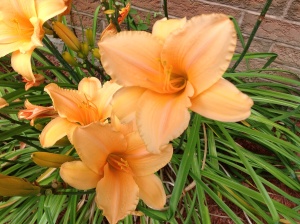The daylily is often called “the perfect perennial,” due to its dazzling colors, tolerance for dry soil, capability to thrive in many zones, and ability to endure in a garden with little or no care. Daylilies establish quickly, grow vigorously and survive winter with little or no injury. Many of the plants that we call lilies — canna lily, lily of the Nile, daylily and calla lily — are, in fact, not lilies at all. True lilies, such as the popular oriental, asiatic, and trumpet types grow from bulbs. The daylily belongs to the genus hemerocallis – an appropriate name, since each flower lasts one day.

Growing daylilies
Daylilies thrive in full sun, although certain daylilies require partial shade, depending on their color. Lighter shades, such as yellow, pink, and pastels require the sun to bring out all of their color. Darker daylilies, such as some red and purple flowers, need shade because their darker colors absorb heat. Each daylily plant produces an abundance of flower buds that open over a long period of time. There are many varieties, a wide range of flower colors, and the flowers continue during the heat of the summer. Varieties with muliticolored blooms, often with a contrasting “eye,” or center, are increasingly popular.
Daylilies have a relatively short blooming period, depending on the type of daylily. There are a variety of different daylilies; some of which will bloom in early spring, while others wait until the summer or even fall. Most daylilies bloom for one to five weeks, although there is a type of daylily known as a rebloomer, which will bloom twice in one season. Depending on the variety, heights range from 1 to 4 feet, with flower stalks on the tallest varieties reaching 6 feet. Depending on the species and cultivar, daylilies grow in USDA plant hardiness zones 1 through 11, making daylilies some of the more adaptable landscape plants.
And with more than 13,000 types available, deferring to daylilies that have gained the Royal Horticultural Society’s Award of Garden Merit can make your decision easier:
Beloved returns • Berlin lemon • Berlin red • Berlin red velvet • Burning daylight • Cartwheels • Chief Sarcoxi • Corky • Golden chimes • Green flutter • Helle Berlinerin • H. lilioasphodelus • Lemon bells • Marion Vaughn • Missenden • Neyron rose • Nova • Pink damask • Red precious • Royal Mountie • Stoke Poges • Tetrina’s Daughter • Whichford
http://www.pinterest.com/greatponds/flowers-daylilies
Planting instructions
In the north, lilies should be planted in spring, spacing plants 1 to 3 feet apart. Daylilies are commonly used in perennial flower borders, planted in large masses, or as a ground cover on slopes, where they form a dense mat in just a few years. Daylilies should not be planted near trees and shrubs as they can compete for moisture and nutrients. Although daylilies are adaptable to most soils, they do best in a slightly acidic, moist soil that is high in organic matter and well drained.
